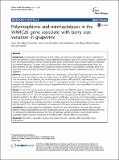Por favor, use este identificador para citar o enlazar a este item:
http://hdl.handle.net/10261/146113COMPARTIR / EXPORTAR:
 SHARE SHARE
 CORE
BASE CORE
BASE
|
|
| Visualizar otros formatos: MARC | Dublin Core | RDF | ORE | MODS | METS | DIDL | DATACITE | |

| Título: | Polymorphisms and minihaplotypes in the VvNAC26 gene associate with berry size variation in grapevine |
Autor: | Tello, Javier CSIC ORCID ; Torres-Pérez, Rafael CSIC ORCID ; Grimplet, Jérôme CSIC ORCID; Carbonell-Bejerano, Pablo CSIC ORCID; Martínez-Zapater, José M. CSIC ORCID; Ibáñez Marcos, Javier CSIC ORCID | Palabras clave: | Association genetics Phylogenetics NAC transcription factor Haplotype Fruit size Fruit growth Vitis vinifera L. |
Fecha de publicación: | 23-oct-2015 | Editor: | BioMed Central | Citación: | BMC Plant Biology 15: 253 (2015) | Resumen: | [Background] Domestication and selection of Vitis vinifera L. for table and wine grapes has led to a large level of berry size diversity in current grapevine cultivars. Identifying the genetic basis for this natural variation is paramount both for breeding programs and for elucidating which genes contributed to crop evolution during domestication and selection processes. The gene VvNAC26, which encodes a NAC domain-containing transcription factor, has been related to the early development of grapevine flowers and berries. It was selected as candidate gene for an association study to elucidate its possible participation in the natural variation of reproductive traits in cultivated grapevine. [Methods] A grapevine collection of 114 varieties was characterized during three consecutive seasons for different berry and bunch traits. The promoter and coding regions of VvNAC26 gene (VIT_01s0026g02710) were sequenced in all the varieties of the collection, and the existing polymorphisms (SNP and INDEL) were detected. The corresponding haplotypes were inferred and used for a phylogenetic analysis. The possible associations between genotypic and phenotypic data were analyzed independently for each season data, using different models and significance thresholds. [Results] A total of 30 non-rare polymorphisms were detected in the VvNAC26 sequence, and 26 different haplotypes were inferred. Phylogenetic analysis revealed their clustering in two major haplogroups with marked phenotypic differences in berry size between varieties harboring haplogroup-specific alleles. After correcting the statistical models for the effect of the population genetic stratification, we found a set of polymorphisms associated with berry size explaining between 8.4 and 21.7 % (R2) of trait variance, including those generating the differentiation between both haplogroups. Haplotypes built from only three polymorphisms (minihaplotypes) were also associated with this trait (R2: 17.5 - 26.6 %), supporting the involvement of this gene in the natural variation for berry size. [Conclusions] Our results suggest the participation of VvNAC26 in the determination of the grape berry final size. Different VvNAC26 polymorphisms and their combination showed to be associated with different features of the fruit. The phylogenetic relationships between the VvNAC26 haplotypes and the association results indicate that this nucleotide variation may have contributed to the differentiation between table and wine grapes. © 2015 Tello et al. |
Versión del editor: | http://doi.org/10.1186/s12870-015-0622-2 | URI: | http://hdl.handle.net/10261/146113 | DOI: | 10.1186/s12870-015-0622-2 | Identificadores: | issn: 1471-2229 |
| Aparece en las colecciones: | (ICVV) Artículos |
Ficheros en este ítem:
| Fichero | Descripción | Tamaño | Formato | |
|---|---|---|---|---|
| berry_size_Tello.pdf | 2,06 MB | Adobe PDF |  Visualizar/Abrir |
CORE Recommender
PubMed Central
Citations
14
checked on 19-abr-2024
SCOPUSTM
Citations
30
checked on 23-abr-2024
WEB OF SCIENCETM
Citations
28
checked on 28-feb-2024
Page view(s)
234
checked on 24-abr-2024
Download(s)
260
checked on 24-abr-2024

